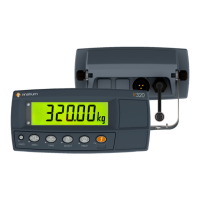Communications Manual Rev 3.10 Software Versions 3.xx
003R-618-310
Page 31
8.1.2. Linearisation
Adding linearisation points is similar to span calibration using test weights.
The desired weight value is written to REG_WEIGHT_CALIBRATION. To delete a
point, set this value to zero.
Place the test weight on the scale.
Execute REG_CALIBRATE_LINx to add the point “x” to the calibration points (1 ≤ x
≤ 5).
Check REG_SYSTEM_STATUS for any errors.
eg. Assume an indicator that has been calibrated for zero and span at 3000 g. Add
a linearisation point L1 at 1000g.
Write calibration weight
20120100:3E8
REG_WEIGHT_CALIBRATION
81060100:0000
Add calibration weight
Execute linearisation L1
20040021:
REG_CALIBRATION_LIN1
81100104:0000
Unit shows “L. in P”
Check status
20040021:
81040021:00002000
Busy Calibrating
20040021:
81040021:00000000
Completed successfully
eg. Deleting Linearisation point L1.
Write calibration weight
20120100:0
REG_WEIGHT_CALIBRATION
81060100:0000
Execute linearisation L1
20040021:
REG_CALIBRATION_LIN1
81100104:0000
Check status
20040021:
81040021:00000000
Completed successfully
8.2. Save Settings to EEPROM
When an indicator is switched on, it retrieves the last saved settings from EEPROM.
When settings are modified by writing to or executing a register, the value is not
automatically saved to EEPROM. If the unit is switched off or power is interrupted,
the new setting will be lost. Executing REG_SAVE_SETTINGS will save the current
settings to EEPROM.
eg. Save settings to EEPROM.
Save Settings
20100010:
REG_SAVE_SETTINGS
81100010:0000

